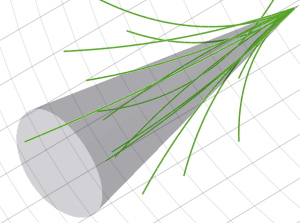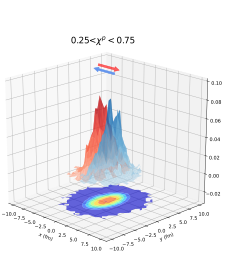Despite the challenges from the pandemic, 2021 was a year of lots of interesting results. It was therefore specially satisfactory to get two paper accepted in Physical Review Letters at the end of the year. This is the fruit of the hard work from the researchers in the heavy-ion group, Daniel Pablos and Yilun Du, who really made the results very interesting.

The first paper that was accepted introduces a novel theoretical framework to compute the jet spectrum in heavy-ion collisions. A jet, for instance as seen in the picture, created at the instance when two lead nuclei smash into each other, has a long and ardous journey through the debris of the collision toward the detectors. In course of its motion, it is constantly evolving by cascading into a collimated bunch of particles. This is the process that we have been working on understanding and calculating to high precision. This calculation involves many elements, from a precise description of jet particles start radiating when interacting with the medium to simulating the jet propagation through a realistic hydrodynamic model of the quark-gluon plasma. Most importantly, our framework is able to decide which jet particles are actually resolved by the medium and which ones are quantum-mechanically invisible to it. This allows for a great description of experimental data harvested at the LHC collider in CERN.
The main output of the paper is the new understanding of the uncertainties in this particular observable. For narrow jets, that is jets with small cone angle, our uncertainties are under good control. For wider jets, however, detailed modeling of the jet-plasma interface is needed. This paves the way for future improvements that we are already working on.

The second paper is based on a novel technique, published here, that estimates the energy of a jet before it gets modified by the medium. It is based on an application of machine learning where we train the algorithm on images of a set of typical jets produced in heavy-ion collisions. As discussed in a previous blog post, this allows us to single out jets that have experienced strong medium modifications and that can teach us more about how they are structured. However, in the latest work, we utilized this information to tell us about the production points of the jets. This is very similar to the tomography known in medical applications, where one estimates the density of tissues based on the deviation of a test beam.
One of the most striking examples is visualized in the figure on the right. At the bottom, we can see the density of the quark-gluon plasma that has been formed where the two nuclei overlapped in the collision (the collision was not completely head-on, therefore the almod shape). Jets that have experienced a lot of quenching have had to travel a long distance through the medium. Therefore, if we look at jets that have been produced in the reaction plane, that is along the short axis of the almond, they had to be produced on the “back side” of the medium and had to travel all the way through to the other side. This is visualized by the red histogram, representing the production points of such jets, and that has a clear peak to the left of the hot area in the middle.
Altough our estimation has uncertainties associated to it, our technique could pave the way for a new way of selecting jets with desired characteristics or originating from special areas in order to more precisely probe the jet-medium interactions that we are ultimately interested in!
We hope to see many more such successes for our team in 2022!
